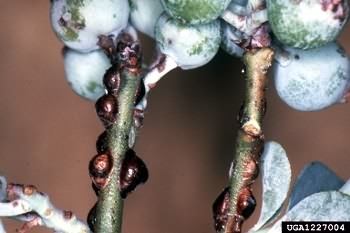Pests
Parthenolecanium corni Bouche. - European Fruit Scale.
Systematic position.
Class Insecta, order Homoptera, suborder Coccoidea, family Coccidae, genus Parthenolecanium Sulc.Synonyms.
Lecanium coryli L. (partly), Eulecanium corni Bouche, Lecanium corni Bouche.European Peach Scale.
Biological group.
Pest of fruit crops.Morphology and biology.
Adult female immovable with oviform and convex body. Body 3.0-6.5 mm in length, 2.0-4.0 mm in width, 4.0 mm in height. Dead females dark yellow or dark brown. Scale smooth and shiny with distinct carina. Body and carina with lateral rows of punctures. Suctorial mouthpart. Antenna 7-segmented, rarely 8- or 6-segmented. Legs tiny; claw with small denticle. Adult male has 2 wings and 3 pairs of eyes; antenna are 10-segmented (2nd segment nearly globular). Legs tiny, tibia with long apical spine, tarsus 1-segmented, claw without denticle. Male body length is 1.7 mm. Lifecycle of female includes egg stage, 2 instars of nymph, and adult. Male has 4 nymph stages. The 1st instar of nymph (crawler) is light yellow; its body length is 0.48-0.52 mm, elongate-oval, strongly narrowing toward posterior end. Small eyes are situated at antennae level at edge of upper side of the body; antenna 6-segmented; suctorial beak 1-segmented; legs moderately thickened. Body length of 2nd instar nymph is 0.9 mm, width 0.4-0.45 mm. Antennae 6-7-segmented; eyes the same as in the 1st nymph instar. Adult females emerge in spring when average daily temperatures reach 13.5°C. Adult female (in the 1st week after emergence) and the 2nd nymph instar have long, tiny waxen filaments along lateral sides of body.Distribution.
Distributed throughout Europe (except Polar territories), Northern Africa, Iran, Afghanistan, China, Korea, North America, Argentina, Australia, and New Zealand. In the former USSR, it inhabits the European region (from the middle taiga sub-zone in the Leningrad region in the North south to southern state boundaries), Southern Ural, Northwestern and Southern Kazakhstan, Central Asia (except mountain territories), Southern Krasnoyarsk Territory, the Primorskii Territory, and Southern Sakhalin.Ecology.
Mesophilous and polyphagous species. Inhabits trees, shrubs, and herbs, mainly found on leaves, branches, trunks, and, to a lesser degree, fruits. The 2nd nymph instar hibernates on trunks and on undersides of branches. In spring, after hibernation, the nymphs migrate to young twigs and remain there for the rest of their lifecycle. Males occur rarely; their numbers reach about 5% of population on plum and hazel. Males fly in the beginning of May. Monovoltine in the northern part of the distribution area, 2-3-voltine in the Southern European region, Transcaucasia and Central Asia. Bisexual population is usually monovoltine. At the end of spring, the female lays eggs under her body. Fertility is 1000-3000 eggs. Crawlers emerge in the beginning of summer. They migrate on the undersides of leaves for feeding. Before hibernation, the 2nd-instar nymphs return to branches. Blastotrix confusa Erd., Microterus sylvius (Dalm.), Coccophagus lycimnia (Walk.), and Metaphicus insidiosus Merc are parasites of P. corni.Economic significance.
Mainly a pest of plum, currant, locust, hazel, raspberry, grape, persimmon, and, to a lesser degree, of apple, pear, apricot, quince, gooseberry, peach, cherry, and mulberry. Usually causes local damage. Larger pest populations are observed in shady and thickened plantations. Young fruiters are more susceptible to injury. Infested trees lose leaves and decrease their annual growth; saprophytic fungi develop on honeydew with strong infestation. Thinning of plantations, burning the falling leaves and infested branches are preventive control measures against P. corni.Related references:
Batiashvili, I.D. 1959. Pests of continental and subtropical fruit crops. Tbilisi: Institut sel'skogo khozyaistva. 455 p. (in Russian).Borkhsenius, N.S. 1949. Suborder Coccoidea. In: Pavlovskii E.N. & Shtakelberg A.A., eds. Pest Animals of Middle Asia (handbook). Moscow & Leningrad: AN SSSR. P. 220-222 (in Russian).
Borkhsenius, N.S. 1957. Suborder Coccoidea, Family Coccidae. Fauna of the USSR. Insecta - Homoptera. Moscow & Leningrad: AN SSSR. V. 9. 494 p. (in Russian).
Borkhsenius, N.S. 1973. Practical key to Coccoidea of cultural and forest plants in the USSR. Leningrad: Nauka. 311 p. (in Russian).
Danzig, E.M. 1984. Suborder of Coccinea. In: Keys to harmful and useful insects and mites on fruit and berry crops in the USSR. In: Kopaneva, L.M., ed. Leningrad: Kolos. 288 p. (in Russian).
Konopleva, V. 1964. European fruit scale. In: Agriculture of Siberia and Far East (Omsk) 6: 82 (in Russian).
Konstantinova G.M. Dangerous Coccoidea Species of Apple Trees. In: Proceedings of the Central Research Laboratory of Plant Quarantine, 1. Moscow: 28-84. (in Russian).
Kryzhanovskii, O.L. & Dantsig, E.M., eds. 1972. Insects and mites - pests of agricultural plants. V. 1. Insects with hemimetabolous development. Leningrad: Nauka, 323 p. (in Russian).
Saakyan-Baranova, A.A., Sugonyaev, E.S. & Sheldeshova, G.G. 1971. Brown fruit scale (Parthenolecanium corni Bouche) and its parasites (Chalcidoidea). In: Essay of the complex investigation of host-parasite relations. Leningrad: Nauka. 167 p. (in Russian).
Savkovskii, P.P. 1976. Atlas of the pests of fruit and berry plants. Kiev: Urozhai. 207 p. (in Russian).
Talitskii, V.I. 1954. Diaspididae and Coccidae - the pests of fruiters in Moldavia. Kishinev: Gos. Izd. 46 p. (in Russian).
Vasil'ev V.P., 1955. Pests of orchards. Kiev: AN Ukr.SSR. 265 p. (in Russian).
Vasil'ev, V.P., ed. 1973. Pests of agricultural crops and forest plantations. V. 1. Kiev: Urozhai. 496 p. (in Russian).


